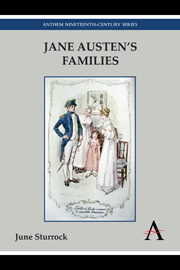General Introduction
Summary
Jane Austen's families are not, for my purpose, the Austens, the Austen-Leighs, the Leigh Perrots, or the Knights — actual historical families. My concern is with the Bennets, the Dashwoods, the Bertrams — with the many fictional families whose dynamics are crucial both to Jane Austen's plots and to her explorations of ethical complexities. Most Austen criticism tends to direct its attention to the interactions of the lovers in the various novels. Given Austen's narratives, this concern is inescapable: the relations between Elizabeth and Darcy and between Emma and Mr Knightley, for instance, are crucial to my arguments at various points in this book. Yet my principal interest is the central characters in interaction with their own families and (to a lesser extent) with other family groups, interactions that both foster and retard emotional and moral development.
Significantly, Austen chooses not to write about orphaned heroines, in this respect contrasting strongly with her contemporaries, Frances Burney (Evelina, Camilla, Cecilia), Ann Radcliffe (Emily St Aubert) and Maria Edgeworth (Belinda), and her successors, Charlotte Brontë (Jane Eyre, Shirley Keeldar, Caroline Helstone, Lucy Snowe), George Eliot (Dorothea Brooke, Dinah Morris, Hetty Sorrel) and so on. “Orphan” narratives are convenient enough for many novelists, allowing a protagonist to experience the shocks of the world without the usual parental buffers, but for a writer such as Austen, who cares intensely for what is natural, possible and probable in fiction, the most common early experience of surviving the pains and pleasures of family life provides far richer material.
- Type
- Chapter
- Information
- Jane Austen's Families , pp. 1 - 8Publisher: Anthem PressPrint publication year: 2013



